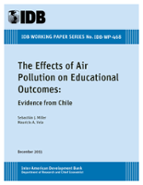The Effects of Air Pollution on Educational Outcomes: Evidence from Chile
Date
Dec 2013
In addition to the morbidity and mortality concerns of outdoor air pollution, studies have shown that air pollution also generates problems for children`s cognitive performance and human capital formation. High concentrations of pollutants can affect children`s learning process by exacerbating respiratory illnesses, fatigue, absenteeism and attention problems. The purpose of this work is to analyze the possible contemporary effects of PM10 and other different air pollutants on standardized test scores in Chile. It examines results for 3,880 schools in the Metropolitan, Valparaiso and O'Higgins regions for children in fourth, eight and tenth grades between 1997 and 2012. Data for particulate matter (PM10 and PM2. 5), carbon monoxide (CO), nitrogen oxide (NOx) and ozone (O3) were interpolated at school level using a kriging methodology. The results suggest that higher annual P M10 and O3 levels are clearly associated with a reduction in test scores. Nonetheless, as of 2012 many municipalities in these Chilean regions are still exceeding the annual P M10 international standard quality norm (50 micrograms per cubic meter) by 15 micrograms per cubic meter on average. Efforts to reduce pollution below this norm in the most polluted municipalities would account for improvements in reading and math test scores of 3.5 percent and 3.1 percent of a standard deviation, respectively.



